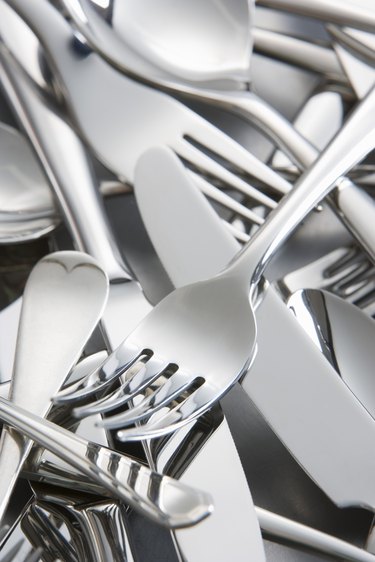
The designation 18/10 refers to the ratio of metals in stainless steel. More specifically, 18/10 means that the stainless steel flatware has roughly 18 percent chromium and 10 percent nickel. Chromium gives stainless steel its rust and stain-resistant properties, while nickel gives it its color. 18/10 is the most common grade of stainless steel flatware, and it is essentially identical to 18/8 flatware. Over time, you might notice that the flatware will become discolored. This is normal for stainless steel and can occur for several reasons.
Strong Acid Cleaners
Video of the Day
Using the right cleaning solutions on stainless steel is vital to keeping its color. If you use a strong acid cleaner, such as muriatic or hydrochloric acid, on your stainless steel flatware it will get discolored. Strong acids such as these are common in drain cleaners or rust removers. Don't use stainless steel flatware to stir acidic cleaners or scrape them out of the container. Keep stainless steel flatware away from the solutions, as even the fumes can cause discoloration.
Video of the Day
Food Residue
Some food residue, especially acidic food such as tomato sauce or lemon juice, can cause discoloration on your flatware. This, however, generally only occurs if you leave the flatware soaking in the food residue for a long time. Don't leave stainless steel flatware in leftover containers, and clean any food residue immediately after using the flatware.
Iron Water
Some areas are known for having a lot of iron in their tap water. This generally occurs when the ground water has runoff from an iron deposit. While it does not generally affect your health, it could cause slight discoloration in your stainless steel flatware. The only way to prevent this is to install a water conditioner in your home that would remove excess iron in the water.
Heat
Heat can discolor stainless steel flatware, but generally pots are more susceptible to this type of discoloration. Heat discoloration could happen on flatware if it falls in the heating unit in your dishwasher or if you leave the flatware in a pot while on heat or directly on a hot stove.
Remove Discoloration
While some intense discoloration may be permanent, you can remove light discoloration from stainless steel flatware with stainless steel polish. This will buff off the discoloration and, in most cases, it will restore the finish and sheen.